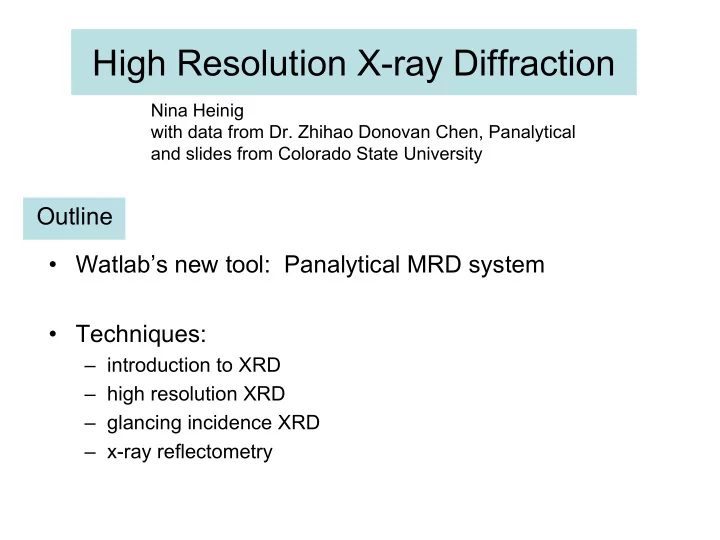

High Resolution X-ray Diffraction Nina Heinig with data from Dr. Zhihao Donovan Chen, Panalytical and slides from Colorado State University Outline • Watlab’s new tool: Panalytical MRD system • Techniques: – introduction to XRD – high resolution XRD – glancing incidence XRD – x-ray reflectometry
4-circle goniometer X-ray source Detector Panalytical’s Materials Research Diffraction System (MRD-Pro)
Introduction to X-ray diffraction Bragg's Law: n λ = 2d sin θ λ = x-ray wavelength, CuK α 1 =1.540562 Å d = crystal lattice spacing θ = incident angle For a single crystal sample, Bragg’s law will result in diffracted spots in space. These can be mapped onto an Ewald sphere , and assigned to various diffraction planes. For a multi-crystal powder sample, the large number of diffracted spots form rings.
Powder Diffraction is widely used to determine unknown inorganic phases. A powder scan involves moving the incident angle (called θ or ω ), and the detector angle (called 2 θ ), simultaneously, so that ω is ½(2 θ ). This will satisfy the Bragg condition for a range of d-spacings. Cu nanoparticles on Si/Au/PPy. 300 250 Fe nanoparticles on Si. 240 230 Only Au peaks are seen. 220 210 Signal/noise is bad. 200 190 180 200 170 160 Lin (Counts) 150 140 130 120 110 100 90 100 80 70 60 50 40 30 20 10 0 0 35 36 37 38 39 40 41 42 43 44 45 46 47 48 49 50 51 52 20 30 40 2-Theta - Scale 2theta (degree) M ar k 1 - Fi l e: M ar k1. r aw - Type: 2Th/ Th l oc k ed - St ar t : 35. 000 ° - End: 52. 000 ° - St ep: 0. 020 ° - St ep t i me: 1. s Karan1 - File: Karan1.raw - Type: 2Th/Th locked - Start: 10.000 ° - End: 40.950 ° - Step: 0.050 ° - Step time: Oper at i ons : I m por t 40-1139 (I) - Iron Oxide - Fe2O3 - Y: 19.19 % - d x by: 1. - WL: 1.5406 - Hexagonal - 04- 0784 ( * ) - G ol d, s yn - Au - Y: 10. 04 % - d x by : 1. - W L: 1. 5406 - Cubi c - 04- 0836 ( * ) - Copper , s y n - Cu - Y: 10. 04 % - d x by : 1. - W L: 1. 5406 - Cubi c - 22-0346 (Q) - Iron Hydroxide - Fe(OH)3 - Y: 20.83 % - d x by: 1. - WL: 1.5406 - Cubic -
Single crystal diffraction is used widely for drug discovery and to analyze large biomolecules. Large molecules can have thousands of diffracted spots, making it a challenge to determine the structure. This technique also requires “large” single crystals of the biomolecule.
High Resolution X-ray Diffraction What affects how accurately Bragg’s law is followed? - monochromacity of the x-ray beam (i.e. how accurately do we know λ ?) - dispersion of the x-ray beam (i.e. how parallel is the beam?) - accuracy and step-size of the goniometer - noise in the detector -Sample Artifacts: small sample size defects/impurities in the crystal lattice diffuse scattering from amorphous material
High resolution XRD : SrTiO 3 (002) Rocking Curve Fix 2 θ at a known Bragg reflection, and FWHM = 0.269 ˚ move (rock) ω about ½(2 θ ). The width of the peak indicates the perfection of the crystal. This single crystal film is highly crystalline (i.e. few defects), but contains some mis-aligned grains.
SrTiO 3 (002) Reciprocal Space Map A more detailed look at the Bragg reflection seen in the rocking curve.
SrTiO 3 (002) In-Plane Rocking Curve Most of the film has the STO (002) crystal axis SrTiO 3 perpendicular to the film surface. An in-plane rocking curve shows part of the STO film consists of mis-aligned grains that have the STO (002) crystal axis parallel to the film surface. FWHM = 0.868° AFM or SEM shows small nano-crystals in the film. YBa 2 Cu 3 O 7-x
Glancing Incidence X-ray Diffraction (GIXRD) GIXRD can determine the diffraction pattern from a very thin film or layer. This is sometimes difficult with ordinary diffraction, because 1) small volume of material in the film 2) strong contribution from the substrate swamps out film data
When the angle of incidence of the x-ray beam decreases, the beam will not penetrate ( refract ) as deeply into the sample. Any light hitting an interface can have a reflected and refracted component. Below a critical angle, α c , total external reflection will occur. Much of the x-ray beam is reflected, and the refracted beam propogates parallel to the interface, while being exponentially damped below the interface. This refracted beam is what is used by GIXRD. The exact details of penetration depth, intensities etc., are found by solving Maxwell’s equations for the case with a boundary condition.
GIXRD shows Au and Cu phases for Cu nanoparticle on PPy/Au/Si
Au nano-particles on Si, seen using GIXRD Au (111) Au (200)
X-ray Reflectivity (XRR) X-ray reflectivity occurs when x-rays hit the sample at low incident angles The reflection occurs at the interface. So the film does not have to be crystalline. Amorphous, disordered films are also ok.
X-ray reflectivity limitations If the films are rough, or do not have even thickness, the interference are washed out. Also, the film layers must have different electron densities to get reflection from the interface. Many orders of magnitude in x-ray intensity are needed. Therefore, big samples are better.
XRR on Cr/Glass sample (8x4 cm 2 )
Summary • Thin film XRD system has varied capability. • Complete analysis of SrTiO 3 structure in reciprocal space using HRXRD. • Accurate phase identification of nanoparticles using GIXRD. • Can determine of film thickness, density and roughness by XRR method
Recommend
More recommend